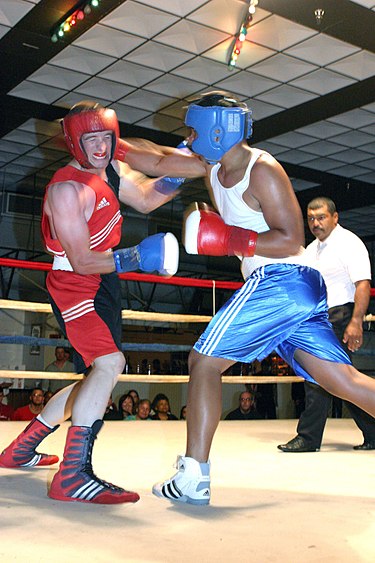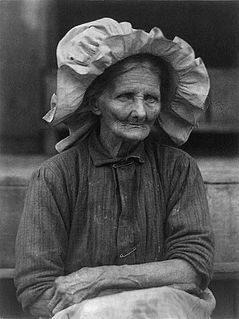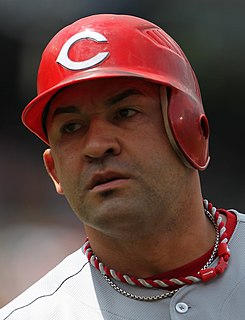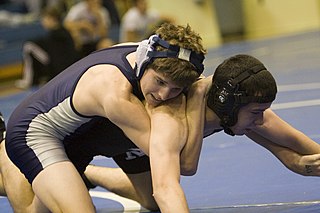This article needs additional citations for verification .(January 2021) |

Headgear is padded helmet worn during sparring in the martial arts.
This article needs additional citations for verification .(January 2021) |

Headgear is padded helmet worn during sparring in the martial arts.
In June 2013 AIBA repealed mandatory headgear for amateur elite male boxers (19–40 years old).
Headgear is a padded helmet, worn on the head by contestants in Amateur and Olympic boxing. It effectively protects against cuts, scrapes, and swelling, but it does not protect very well against concussions. It will not protect the brain from the jarring that occurs when the head is struck. Also, most boxers aim for the chin on opponents, and the chin is usually not protected by headgear.
There are different types of boxing headgear available. Some headgear is open-faced. This is the style normally used in amateur boxing competitions. Unlike open-faced headgear, training headgear covers the cheek. "Face-saver" headgear features a pad across the face so that no direct contact is made to the face. As the amount of padding in headgear is increased, visibility is reduced.
Boxing Headgear will reduce the impact of a hit by 40-60%.[ citation needed ]
It has lately[ when? ] been noted that the use of headgear might in fact be less safe than not using it due to an increased rate of brain damage, particularly outside professional boxing. Due to this, headguards were not used in the 2016 Summer Olympics. There are three theories for why use of headgear might lead to more brain damage: the headguard makes it more difficult to see, it makes ones head a bigger target and it might create a false sense of security, leading the boxer to take more risks than they otherwise might. As such, use of 16oz gloves has become more recommended to increase the safety of boxing, as they are heavy enough to prevent the boxer from throwing punches at full speed and power. [1] [2]
Wrestling headgear is designed to protect the ears from damage. It features either soft or hard plastic ear covers and straps around the chin and back of the head. It is commonly used in grappling sports such as amateur wrestling, submission wrestling and Brazilian jiu-jitsu.
Point fighting headgear, which is commonly required in sport karate tournaments is made of a molded and dipped foam. This type of headgear is most common in no contact and semi contact fighting. It is designed to protect against accidental impact, including the head hitting the floor after a slip or knockdown. This sort of headgear can be open face, full faced and sometimes even a full plastic face shield.

Boxing is a combat sport in which two people, usually wearing protective gloves and other protective equipment such as hand wraps and mouthguards, throw punches at each other for a predetermined amount of time in a boxing ring. In a more general way, the term "boxing" can refer to a wide genre of combat sports in which two opponents face each other in a fight using their fists, covered by gloves in most cases and differentiating according to their rules to different sports such as western boxing, french boxing, chinese boxing, thai boxing, kick boxing, or the ancient pygmachia.

Kickboxing is a group of stand-up combat sports based on kicking and punching. The combat takes place in a boxing ring, normally with boxing gloves, mouthguards, shorts, and bare feet to favor the use of kicks. Kickboxing is practiced for self-defence, general fitness, or as a contact sport.
Martial arts are codified systems and traditions of combat practiced for a number of reasons such as self-defense; military and law enforcement applications; competition; physical, mental, and spiritual development; entertainment; and the preservation of a nation's intangible cultural heritage.

Muay Thai , sometimes referred to as "Thai boxing," is a martial art and combat sport that uses stand-up striking along with various clinching techniques. This discipline is known as the "art of eight limbs," as it is characterised by the combined use of fists, elbows, knees, and shins. Muay Thai became widespread internationally in the late 20th to 21st century, when Westernised practitioners from Thailand began competing in kickboxing and mixed-rules matches as well as matches under Muay Thai rules around the world. The professional league is governed by The Professional Boxing Association of Thailand (P.A.T), sanctioned by The Sports Authority of Thailand (S.A.T.).

Boxing training is the training method that boxers use in order to get more fit for their sport.

A motorcycle helmet is a type of helmet used by motorcycle riders. Motorcycle helmets contribute to motorcycle safety by protecting the rider's head in the event of an impact. They reduce the risk of head injury by 69% and the risk of death by 42%. Their use is required by law in many countries.

Bonnet has been used as the name for a wide variety of headgear for both sexes—more often female—from the Middle Ages to the present. As with "hat" and "cap", it is impossible to generalize as to the styles for which the word has been used, but there is for both sexes a tendency to use the word for pop styles in soft material and lacking a brim, or at least one all the way round, rather than just at the front. Yet the term has also been used, for example, for steel helmets. This was from Scotland, where the term has long been especially popular.

A batting helmet is worn by batters in the game of baseball or softball. It is meant to protect the batter's head from errant pitches thrown by the pitcher. A batter who is "hit by pitch," due to an inadvertent wild pitch or by intent, may be seriously, even fatally, injured.

Cauliflower ear is an irreversible condition that occurs when the external portion of the ear is hit and develops a blood clot or other collection of fluid under the perichondrium. This separates the cartilage from the overlying perichondrium that supplies its nutrients, causing it to die and resulting in the formation of fibrous tissue in the overlying skin. As a result, the outer ear becomes permanently swollen and deformed, resembling a cauliflower.

A combat sport, or fighting sport, is a competitive contact sport that usually involves one-on-one combat. In many combat sports, a contestant wins by scoring more points than the opponent, disabling the opponent, or attacking the opponent in a specific or designated technique. Combat sports share a long pedigree with the martial arts.

Boxing gloves are cushioned gloves that fighters wear on their hands during boxing matches and practices. Unlike "fist-load weapons" which were designed as a lethal weapon, modern boxing gloves are non-lethal, designed to protect both the opponent's head and the fighter's hand during a bout. Sparring and other forms of boxing training have their own specialized gloves.

Throughout the history of gloved boxing styles, techniques and strategies have changed to varying degrees. Ring conditions, promoter demands, teaching techniques, and the influence of successful boxers are some of the reasons styles and strategies have fluctuated.

Sportswear or activewear is clothing, including footwear, worn for sport or physical exercise. Sport-specific clothing is worn for most sports and physical exercise, for practical, comfort or safety reasons. Gym trousers should only be worn for light activity such as weights and not for running or squash.

Wrestling headgear is protection that a person wears over the ears and chin during wrestling matches.
Professionals and amateurs alike wear protective head gear (helmets) to reduce the chance of injury while playing American and Canadian football. The football helmet has changed over time and many different materials have become available. The rules of the game have changed as well.

The scrum cap is a form of headgear used by rugby players to protect the ears in the scrum, which can otherwise suffer injuries leading to the condition commonly known as cauliflower ears. Although originally designed for forwards they are now worn by players of all positions, even those who do not play in the scrum.
Association football headgear is worn by association football players to protect the head from injury. The headgear is designed to absorb the impact of blows to the head by external physical forces in order to reduce the chance of a concussion, a noteworthy example in international football being Czech goalkeeper Petr Čech from Chelsea. These collisions can occur from head to head, head to ground, head to goal post, or head to body extremity contact. It is flexible, not a rigid helmet.

Protective equipment in gridiron football consists of equipment worn by football players for the protection of the body during the course of a football game. Basic equipment worn by most football players include helmet, shoulder pads, gloves, shoes, and thigh and knee pads, a mouthguard, and a jockstrap or compression shorts with or without a protective cup. Neck rolls, elbow pads, hip pads, tailbone pads, rib pads, and other equipment may be worn in addition to the aforementioned basics. Football protective equipment is made of synthetic materials: foam rubbers, elastics, and durable, shock-resistant, molded plastic. Football protective equipment has remained consistent in use for decades with some slight modifications made over the years in design and materials. The assignment and maintenance of football gear belongs to the team equipment manager.

The use of personal protective equipment (PPE) is inherent in the theory of universal precaution, which requires specialized clothing or equipment for the protection of individuals from hazard. The term is defined by the Occupational Safety and Health Administration (OSHA), which is responsible for PPE regulation, as the "equipment that protects employees from serious injury or illness resulting from contact with chemical, radiological, physical, electrical, mechanical, or other hazards." While there are common forms of PPEs such as gloves, eye shields, and respirators, the standard set in the OSHA definition indicates a wide coverage. This means that PPE involves a sizable range of equipment. There are several ways to classify them such as how gears could be physiological or environmental. The following list, however, sorts personal protective equipment according to function and body area.